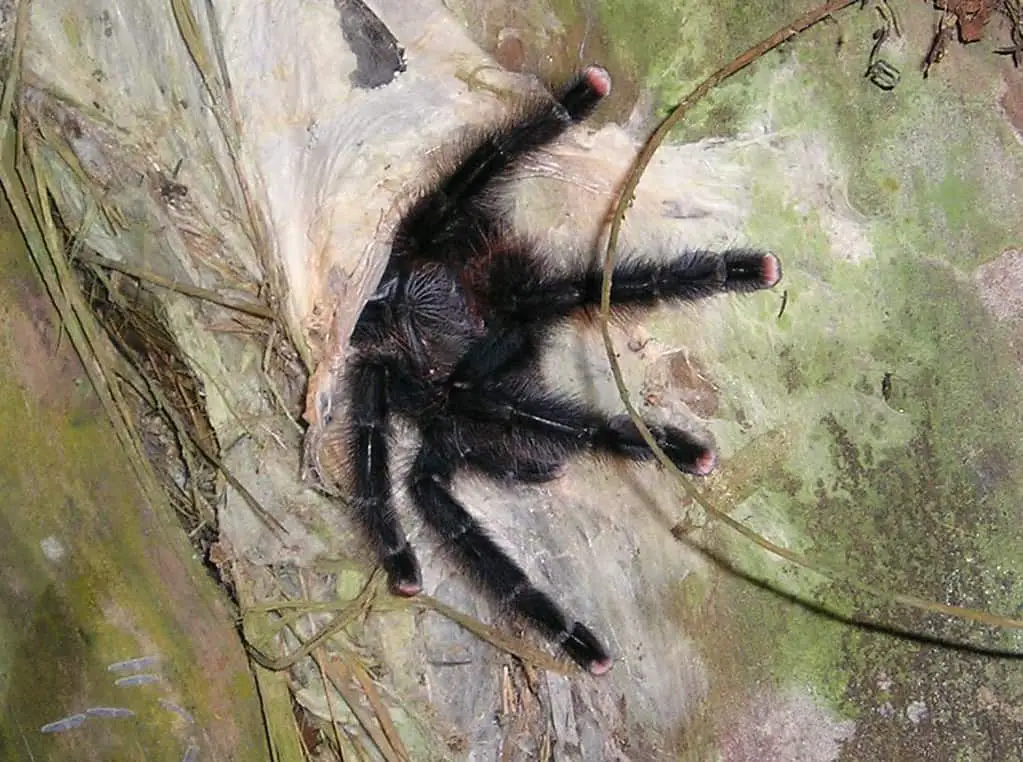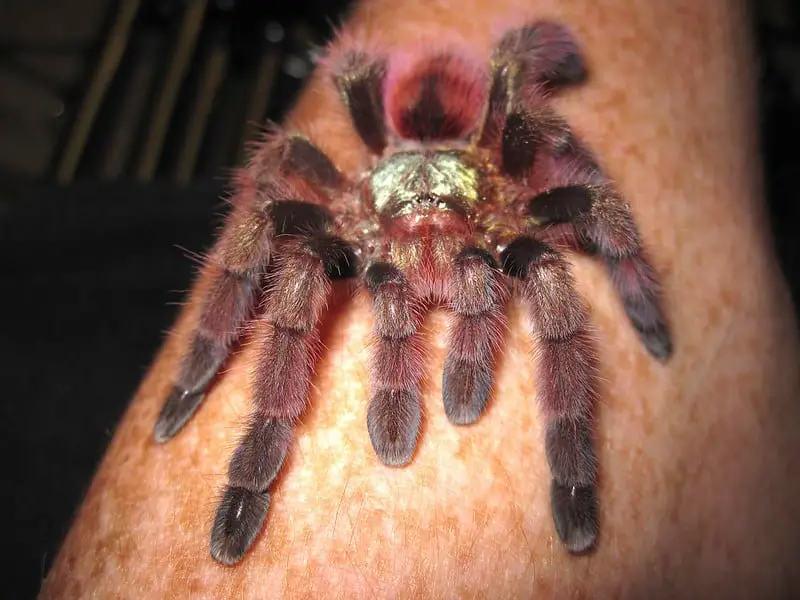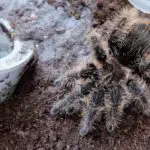The pinktoe tarantula, also known as the Avicularia tarantula, is one of the easiest arboreal tarantulas to take care of. Here’s a quick pinktoe tarantula care guide for beginners.
To keep Pinktoe tarantula, prepare a tall enclosure. Erect a cork bark along the wall of the enclosure and secure it with hot glue or silicon gel. Insert a big water dish at the bottom of the enclosure and house the pinktoe inside the enclosure. Feed the pinktoe with crickets once a week. Replenish the water as it dries.
Sounds easy isn’t it? Continue reading for more details.
Introduction to Avicularia Tarantulas

Avicularia is a genus of tarantulas found in the tropical rainforest of central and south America. They are called the New World tarantulas, which are considerably less venomous than their Old World counterparts.
They are known by the common name pinktoe tarantula due to their pinky feet. Some of the notable Avicularia species include A. avicularia, A. versicolor (reclassified as Caribena versicolor) and A. urticans. Adult Avicularia can grow up to 5 inches.
Being good climbers, pinktoe tarantulas spend most of their time on the trees. They feed mainly on flying insects.
Male pinktoes can live for up to 4 years while female pinktoes can live up to 8 years. Such lifespan is considered short amongst the tarantulas.
While it is generally recommended to keep terrestrial species as your first tarantula, the arboreal Avicularia species are actually quite easy to keep for beginners.
Getting A Pinktoe Tarantula
The best way to get a pinktoe tarantula is by searching forums and social media platforms for breeders. Try to find a breeder who stays near you so that the tarantula doesn’t stay too long in the parcel.
Because pinktoe tarantulas are easy to keep and breed, you will definitely be able to find breeders who sell them outside central and south America.
Get a female pinktoe if you want something that can survive for up to 8 years. If you prefer a shorter commitment period, male pinktoe is a cheaper option.
Try to get an older juvenile or so-called sub-adult instead of an adult or young spiderling. Younger spiders are small and fragile, which makes them harder to take care of. On the other hand, adult tarantulas can be too old because there is no way for you to ascertain their age, except to trust the seller.
Preparing the Enclosure
Pinktoe tarantulas spend most of their time at height and they tend to build their web at the top corners of the enclosure. Hence, you will need a tall enclosure that has a side door. Alternatively, you can convert a long enclosure with top opening by erecting it.
Take a cork bark or driftwood and fit it on the back of the enclosure. That’s where you want your tarantula to spin the web. The cork bark will attract the tarantula to build webs next to it instead of on the door.
You can use either hot glue or silicone glue to fix the cork bark. Some silicone glues (acetoxy type) release acetic acid when curing. Make sure the silicone is fully cured and the enclosure is wiped and ventilated to remove the acetic acid residues as it may harm your tarantula.
Pinktoe tarantulas require no substrates in the enclosure. You can lay artificial grass carpet on the flooring for aesthetic purposes.
Temperature for Avicularia Pinktoe Tarantula
Pinktoe tarantulas prefer a warmer temperature. Keep your pinktoe tarantula at the higher end of room temperature (68 – 77 °F/20 – 25 °C). If your house is slightly warmer than that, it is OK as long as you feel comfortable staying under that temperature. Tarantulas are quite hardy and you don’t have to worry too much about that. Note that tarantulas grow and age faster at a higher temperature.
You will need to provide artificial heating to your pinktoe during winter if it is too cold. What do I mean by “too cold”? If you need to wear a sweater, it is too cold for your pinktoe.
Put a heat mat under a corner of the enclosure to heat up the enclosure. Be careful not to kill your pinktoe by overheating! Putting your pinktoe in a closed cupboard can help to prevent the heat from escaping.
Humidity for Avicularia Pinktoe Tarantula
Pinktoe tarantulas originated from the tropics, which is known for its humid air. Thus, your pinktoe will appreciate a high humidity environment.
Prepare a wide water dish and put it at the bottom of the enclosure. Put some pebbles into the water dish so that the feeder insects can save themselves if they fall into the water.
The water dish will provide enough moisture for the microenvironment in the enclosure. You might also see the tarantula coming down for water. Always keep the water dish filled.
At first thought, you might want to reduce the ventilation to preserve humidity. However, pinktoes require both high humidity and good ventilation. Make sure the enclosure you use has plenty of vents. Insufficient ventilation will harm your tarantula.
Lighting for Pinktoe Tarantula
Like other tarantulas, pinktoe tarantulas don’t require additional lighting. While they are more tolerant to light compared to those burrowing tarantulas, you still need to place them away from direct sunlight.
If you want to observe your pinktoe, use red light if possible because the tarantula is less sensitive to red light. White light will not do significant harm if you want to use it. Just make sure you don’t shine the light onto the tarantula for too long and switch off the light once you’ve done observing.
How to Feed Your Pinktoe Tarantula
The diet of a pinktoe tarantula is simple. Like other tarantulas, they eat all sorts of small prey that you can easily buy from pet stores, including crickets, cockroaches, mealworms and superworms.
On a weekly basis, feed your pinktoe tarantula with 2-4 crickets. Adjust accordingly based on its appetite.
It can take a long time for your pinktoe to catch the crickets because crickets usually dwell at the ground level. If you worry that your pinktoe cannot find the cricket, you can toss the cricket towards the nest. Even if you don’t, your tarantula will eventually understand where to find the cricket.
Don’t worry too much if your pinktoe tarantula refuses to eat. Tarantula will stop feeding before it molts. Just remove the crickets and let it molt. Resume the feeding regime after the newly formed exoskeleton has hardened, which can take a few days.
Remove any remnants of the crickets after each feast.
How to Handle Pinktoe Tarantulas

Generaling, I do not recommend handling pinktoe tarantulas because they are very agile. Pinktoe tarantulas move very fast, and they just don’t stop moving when you try to handle them. They will jump if they need to, so be prepared.
Try not to handle them unless you really need to. And if you need to transfer them, coax it into a cup with a lid to prevent it from running around which may result in unnecessary injury and hassle.
Luckily, pinktoe tarantulas are very docile, and they rarely bite. But, if you disturb them too much, they will poop at you!
Avoid touching the Avicularia tarantulas with your bare hands. While they don’t generally kick their urticating hairs, those hairs can stuck on your hands if you touch them.
Recommended Supplies
Below are the supplies that I recommend you to get for your tarantula. Note that I get a small commission when you buy the items through the links in this page. This helps me to maintain the site without incurring additional costs to you.
Final Words
I hope you find this pinktoe tarantula care guide helpful for you, and wish you have smooth journey in this new hobby. If this is going to be your first pet tarantula, make sure you read my beginners guide on tarantula keeping. Also, check out my recommended books on keeping tarantulas if you wish to learn more about keeping tarantulas.


